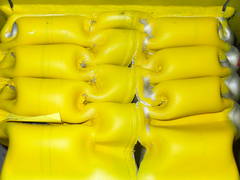Mar 6 2008
A group of structural engineers at Vienna University of Technology (TU) are working on simulating the behaviour of weld seams under crash loading. Particular emphasis is being placed on rail vehicles where, on the one hand, improved crash safety is being demanded and, on the other hand, only a limited number of real crash tests can be performed due to the high costs involved. Simulation models are to allow an improved assessment of the failure of welds in the future.
 Deformed crashbox with partial failure of weld seams.
Deformed crashbox with partial failure of weld seams.
Vienna (TU). At present, crash tests represent the state of the art not only in the automobile industry but also in the rail vehicle sector. In the course of a cooperative project with Siemens Transportation Systems TU researchers investigated the strength of weld seams in rail vehicles under crash loading as part of a research project funded by the city of Vienna (ZIT). “During collisions not only individual structural components but also the joints between them are exposed to enormous loads. Spot welds play an important role in the crash behaviour of motor vehicles, whereas rail vehicles tend to employ continuous weld seams. Both can be critical in the event of a collision”, notes Helmut Böhm, Head of the Institute of Lightweight Design and Structural Biomechanics of Vienna University of Technology (TU).
The reason why welded joints may be subject to failure lies in the thermal conditions they are subjected to during welding. The metal is heated and molten, which can significantly modify its properties. With the aid of computer simulations professor Böhm and project assistant Christian Grohs studied the inhomogeneous and heat affected material involved in weld seams. “The objective is to enable the structure to absorb as much kinetic energy as possible during a crash. It is constructed in such a way that it can be severely deformed, e.g. by developing patterns of folds. This reduces the risk of injury for passengers”, says Helmut Böhm. Christian Grohs adds: “An extensive experimental test programme, which forms the basis for numerical analysis, was defined and carried out in cooperation with the Institute of Materials Sciences and Technology. We can then recheck the test results and construct better models using this data. The test structure was defined in such a way that the weld seams are located at the most unfavourable positions with the aim of inducing them to fail during the test. The models, in turn, serve to improve the design of rail vehicles”.
A new standard on the collision safety of rail vehicles is to be introduced in 2008. Since crash tests of rail vehicles are very expensive, simulations play a major role in verifying their crash behaviour. Such work must demonstrate that gross deformations of rail vehicles are restricted to so-called crash zones which are situated in regions where there are no people. Dr. Seitzberger, crash expert at Siemens Transportation Systems, states: “An intensive basic research-oriented debate on the issue of the passive safety must be regarded as essential for successfully carrying out future projects. The present cooperation represents a significant contribution to the continued development of know-how and competence in this field and will contribute to enhancing the safety of modern rail vehicles”.